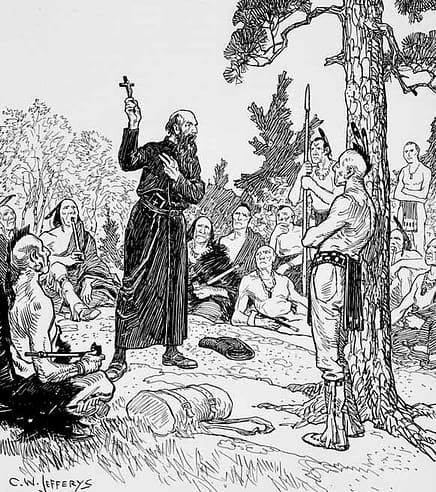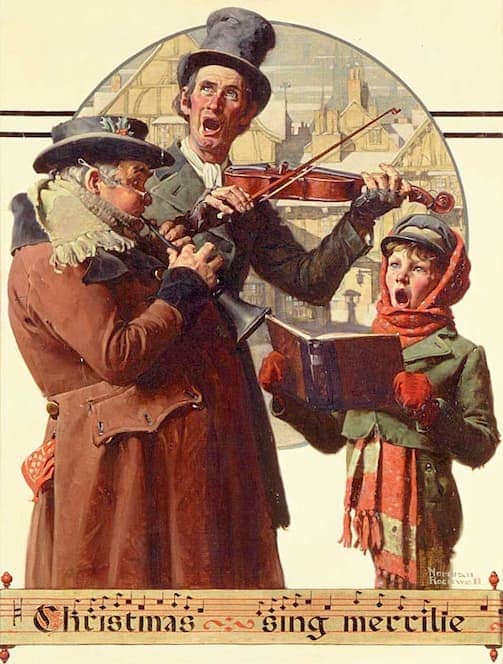The first North American Christmas Carol originated from a Jesuit missionary, Saint John de Brébeuf, to the Huron Indians. Father de Brébeuf wrote, “Jesous Ahatonnia” (“Jesus is Born”) in the Huron language as an adaptation to a 16th-century French folk song.
———————————————————
first north american christmas carol
The Huron was a Northeastern American Indian tribe, whose origin was from the region of central Ontario between the southern area of Georgian Bay and Lake Simcoe. The Iroquois attacked the Huron mission in 1649 and by 1650 defeated them. Father de Brébeuf lived among the Huron from 1626 until 1649 when the Iroquois attacked. The Iroquois brutally tortured, tormented, and butchered Father de Brébeuf alive. Some Huron escaped the Iroquois, taking the hymn with them and preserving it. Eventually, the Huron Carol was discovered among the papers of Father Étienne de Villeneuve after his death in 1794.
After their defeat to the Iroquois, some of the remaining Huron relocated north of Quebec, while others migrated to the southeastern areas of Wisconsin, Minnesota, and upper Michigan. These Huron were known as Wyandot. By 1701, they moved to the Ohio Valley between the current location of Detroit and Cleveland, remaining there until forced by the U.S. Federal government to relocate to Kansas in the 1840s. They were best known for their involvement in the fur trade because of their close trading partnership with Samuel de Champlain, founder of New France.
THE HURON CAROL

Selections from the Pius X Hymnal (English version) (McLaughlin & Reilly Co., Boston) with the exception of the second stanza, which comes from The Christmas Book by Jesuit Father Francis X. Heiser (Harcourt, Brace, and Co., New York. 1952. Pp. 82-84).
Twas in the moon of wintertime
When all the birds had fled,
That mighty Gitchi Manitou
Sent angel choirs instead;
Before their light the stars grew dim,
And wond’ring hunters heard the hymn:
Jesus, your King is born,
Jesus is born,
In excelsis gloria.
O, harken to the angels’ word,
Do not decline
To heed the message which you heard:
The Child Divine,
As they proclaim, has come this morn
Of Mary pure. Let us adore.
Jesus is born,
In excelsis gloria.
Within a lodge of broken bark
The tender Babe was found,
A ragged robe of rabbit skin
Enwrapp’d His beauty ’round;
But as the hunter braves drew nigh,
The angel song rang loud and high:
Jesus, your King is born,
Jesus is born,
In excelsis gloria.
The earliest moon of wintertime
Is not so round and fair
As was the ring of glory on
The helpless infant there.
The chiefs from far before Him knelt
With gifts of fox and beaver pelt.
Jesus, your King is born,
Jesus is born,
In excelsis gloria.
O children of the forest free,
O sons of Manitou,
The Holy Child of earth and heav’n
Is born today for you.
Come kneel before the radiant boy;
Who brings you beauty, peace and joy.
Jesus, your King is born,
Jesus is born,
In excelsis gloria.
CHRISTMAS CAROLING STORY
Caroling is described as an ancient tradition celebrating the winter solstice. The singing of songs from house to house during the winter solstice appeared as early as the Roman era and continued into the 1700s. Wassailing, from the Middle Ages, was a feudal form of the caroling tradition, which enabled society’s less fortunate to approach wealthier homes for charitable offerings of food and drink. Also at that time, a Welsh Candlemas wassailing had carolers singing around town hurling insults at the homes they visited. Interestingly, the homeowners were compelled to return the insults to the carolers and if the homeowner was outsmarted, the carolers were invited inside and given food and drink. Wassailing was also found to have been practiced during Halloween, Christmas, and Candlemas as well.
Mumming was another similar tradition to caroling with roots in ritual and carnival, which may have developed from ancient, pagan folk festivals in agricultural communities. A tradition most commonly practiced in England, Scotland, and Ireland, it also spread to some areas in Europe as well. Mummers were performers who went masked house-to-house entertaining their audiences with folklore drama, music, dance, and sword fighting. Their theme was death and revival, and they animated stories that reflected the onset of a new year. The mumming performance had three components: the initial presentation, the drama play, and a procession at the end. Afterward, the mummers expected compensation for the entertainment with either food, alcohol, or money.
It seems that it took several centuries before the Church disassociated caroling from mumming because of mumming’s pagan roots of rituals and carnivals, heathen dancing, and suspected witchcraft. Some sources claim that the earliest known period of caroling was between the 1300s and 1400s when the Catholic Church finally accepted the practice. This enabled St. Francis of Assisi to rise as a prominent leader for the change of distasteful carols to ones that were more suitable. Many carols were discovered to have been written during the period of 1400 through 1650.
By the mid-19th century, the celebration of Christmas had spread throughout the United States, and the ancient customs of wassailing and mumming were abandoned for a newer style of caroling – the singing of Christian hymns and caroling from house-to-house during Christmas. This revival of caroling was due to the Victorian Era because of its sentimental influence toward family customs and folk cultures from the past, and it continued throughout the mid-20th century. Today, in the early 21st century, this once-popular Christmas tradition is gradually disappearing from North American culture.
commentary

The other day, I played on my piano all my favorite traditional Christmas carols. They reminded me of childhood memories of long-gone Christmases during the 1960s. I lived in suburban Long Island, New York, and I remembered many cold and snowy winters. Then my older mind’s eye drifted to another Christmas past when my own children were very young.
Up in the mountains near our home in upstate New York, we searched the woods for the prettiest Christmas tree to cut down as our own. We gathered pine cones and pine boughs to make evergreen wreaths. Most nights, we’d gather around our fireplace to enjoy the fire and its warmth before going to bed. Our little home was decorated with homemade Christmas crafts, and we entertained the family with home‑cooked meals. There wasn’t much money when they were small, or even when I was a child, but these mementos were romantic keepsakes I wouldn’t trade for all the materialistic things money could buy.
My preference is the old traditional, religious Christmas carols such as Silent Night; Holy Night; Hark! The Herald Angels Sing; O Come, All Ye Faithful; and Joy to the World. These songs were from my childhood and still very much a part of me, but the more popular Christmas songs from the mid‑20th century had to be included in my sentimental recollections as well. Some favorites were White Christmas; Silver Bells; Let It Snow, Let It Snow; Blue Christmas; and I’ll Be Home for Christmas.
The secular holiday songs originated from the moral and idealistic influence of mid-20th century Hollywood movies and television. These songs became very popular with North American society and have continued to endure into the 21st century, remaining the preferred choice over any new holiday songs created today. Sadly, the current North American media has dismissed morality and ideals, peddling a viewpoint that is far less sentimental and far more superficial. The media uses the traditional Christmas celebration as a commercial for worldly materialism, and they do not hide their biased disrespect for the religious meaning of the holiday.
Yet, it is the old religious Christmas carols that give the true meaning of Christmas. The holy event of Christ’s divine birth in Bethlehem over 2,000 years ago. Christ, who is the Word of God and one with the Father from the beginning of time, was incarnated as a human man and spoken into existence by His omnipotence. The Christian truth of this day is the miraculous act of grace by God for humankind and its gift of salvation that offers peace, love, and joy for all.
Merry Christmas and Happy New Year
References
Adoremus Bulletin. 1999. Society for the Renewal of the Sacred Liturgy. Vol. V, No. 9
http://www.adoremus.org/1299-100-Huron.html
Christiansen, R. 2014.
http://www.telegraph.co.uk/topics/christmas/6827563/Why-Christmas-carols-make-the-church-feel-nervous.htm
–http://native-american-indian-facts.com/Northeast-American-Indian-Facts/Huron-Indian-Facts.shtml
Emerick, C. 2013. The Hidden History of Christmas Carols
http://www.medievalists.net/wp-content/uploads/2013/12/The_Hidden_History_of_Christmas_Carols_-_by_Carolyn_Emerick_-_for_Celtic_Guide_December_2013.pdf
Harvester, H. A Short History of Caroling-Traditional Arts in Upstate New York. 2 pp.
http://web.abo.fi/karen/special/steatern/arkiv/2005/material/mummers_play/mummings.html
Regnaut, C. 1649. Jesuit Relations. Vol.34, pp 25-37
http://darkwing.uoregon.edu/~gsayre/Brebeuf.htm
Updated 2020
